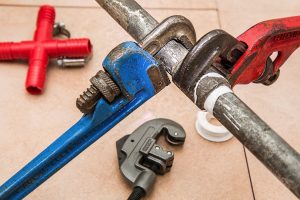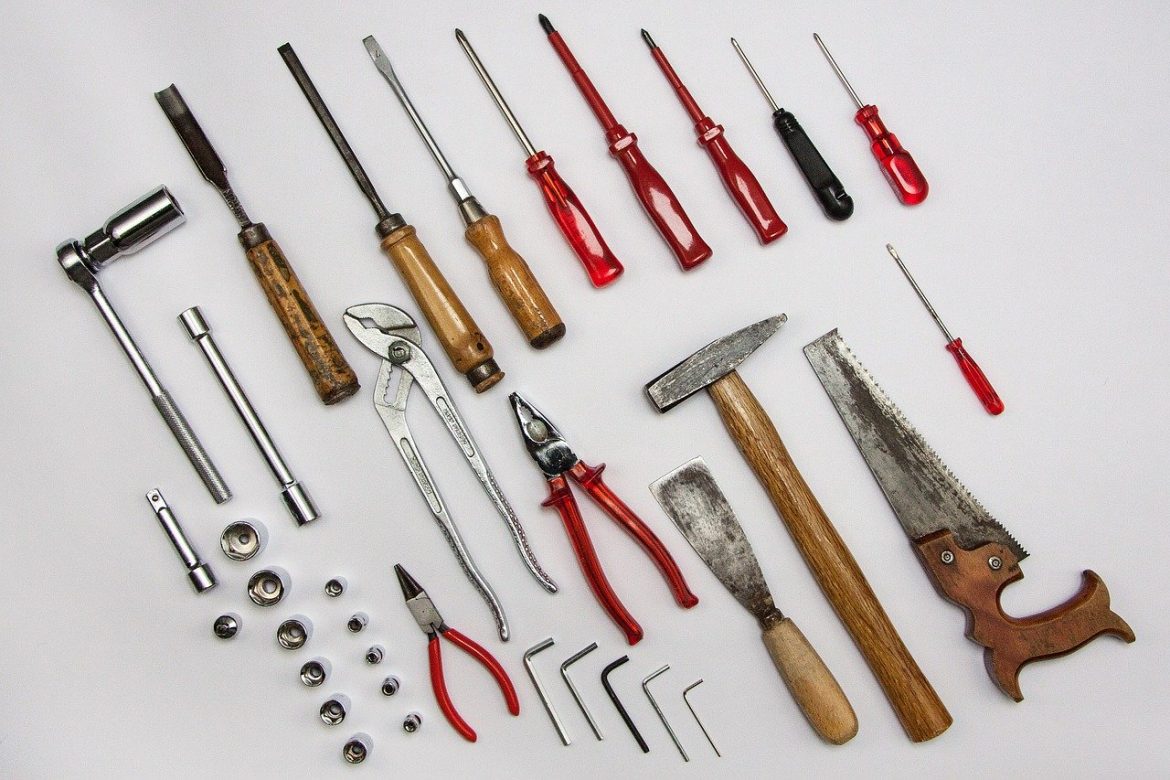W branży instalacyjnej specjalistyczne narzędzia hydrauliczne są potrzebne nie tylko profesjonalistom. Jeśli chcesz dokonać podstawowych zabiegów montażowych lub naprawczych, warto posiadać analogiczne narzędzia, jak fachowcy. Co powinno znaleźć się w skrzynce z narzędziami każdego domowego instalatora?
Podstawowe narzędzia ręczne
W każdej skrzynce narzędziowej nie może zabraknąć podstawowych narzędzi ręcznych. Bez nich praktycznie niemożliwe jest wykonanie nawet drobnych napraw. Charakteryzują się przede wszystkim niską wagą. Do grupy narzędzi ręcznych należą:
- młotki – elementarne przyrządy do wbijania i wyciągania gwoździ, wykorzystywane najczęściej w podstawowych operacjach budowlanych i kontakcie z drewnem (np. podczas montażu mebli),
- gwoździe – wymagane do otrzymania odpowiedniego zabezpieczenia i uformowania powierzchni drewnianych, a w celach komfortu najlepiej zaopatrzyć się w zestawy gwoździ o różnych długościach i szerokościach,
- kombinerki – przydatne przy odkręcaniu śrub, ale pomagają także w przecinaniu drutów czy ściąganiu izolacji z przewodów elektrycznych,
- śrubokręty (zwykłe i krzyżakowe) – niezwykle użyteczne podczas renowacji instalacji elektrycznej,
- metrówki i poziomice – niezbędne głównie przy aranżacjach i wykańczaniu wnętrz, gdy potrzebne jest precyzyjne mierzenie mebli,
- klucze – podstawowe narzędzia do wkręcania i wykręcania śrub. Wykorzystywane zarówno w instalacjach budowlanych, jak i hydraulice, i przydatne w każdej sytuacji dzięki niezliczonym wielkościom oraz przeznaczeniu. Rozróżniamy klucze płaskie, nasadowe, oczkowe, a także szczypce nastawne (sprawdzają się wszędzie tam, gdzie klucze nie poradzą sobie), które umożliwiają odkręcanie, przykręcanie zaworów, montowanie syfonów czy dokręcanie nakrętek.
Elektronarzędzia
Do elektronarzędzi zaliczamy te, które wymagają zasilenia prądem elektrycznym (najczęściej o napięciu 230V) – wiertarki i wkrętarki. Doskonale ułatwią prace remontowe czy wykończeniowe. Wiertarki (np. wiertarka udarowa) przydają się wszędzie tam, gdzie trudno wbić zwykły gwóźdź. Wkrętarka sprawdza się najlepiej przy skręcaniu mebli. Obecnie na rynku możemy znaleźć hybrydy tych dwóch narzędzi – wiertarko-wkrętarki. Umożliwiają one zaoszczędzenie miejsca w skrzynce na narzędzia i zmniejszenie kosztów zakupu.

Narzędzia hydrauliczne
Instalacje hydrauliczne (np. sieci wodociągowych, gazowych, kanalizacyjnych) nie mogłyby być zrealizowane bez odpowiednich przyrządów. Większość z nich jest poręczna. Jednak niektóre narzędzia hydrauliczne mają zdecydowanie większy rozmiar i nie zmieszczą się w typowej skrzynce narzędziowej.
Narzędzia hydrauliczne
Narzędzia hydrauliczne wykorzystywane szeroko w instalacjach hydraulicznych to:
- gwintownice – używamy ich w sytuacjach, gdy potrzebujemy skutecznie i dokładnie wykonać gwintowane połączenia w stalowych rurach. Znajdziemy zarówno gwintownice elektryczne, wyposażone często dodatkowo w m.in. olejarkę czy imadełko, jak gwintownice ręczne, składające się zazwyczaj z gwintowników, głowic do gwintowania i pokrętła. Gwintownice znajdziemy w różnych zestawach (o odmiennych rozmiarach), dlatego można dość łatwo dopasować właściwe przyrządy gwintujące do średnicy wybranej rury.
- obcinaki i nożyce do rur – docelowo zajmują się cięciem i fazowaniem rur. Można je dobierać według odpowiedniej średnicy i rodzaju rur (np. aluminiowych, miedzianych). Wśród bogatych ofert tych narzędzi znajdziemy obcinaki elektryczne, które umożliwiające znacznie szybszą i łatwiejszą pracę. Natomiast narzędzia ręczne są lekkie, proste w obsłudze i dają możliwość pracy nawet bez obecności prądu. Jeżeli chcemy dokonać fazowania rury (utworzenia gładkiej powierzchni), musimy użyć gratownika (np. Gratownik ( gradownik) do rur PE 20 – 63 mm). Zamiast obcinarek można wykorzystać także gotowe maszyny specjalizujące się w precyzyjnym cięciu i fazowaniu rur, jednak w ich wypadku należy liczyć się z wysokimi kosztami i mniejszą poręcznością. Wśród obcinarek możemy znaleźć takie egzemplarze jak Obcinak do rur miedzianych 3-28 mm,, Nożyce obcinak do rur do 16 – 63 mm N czy Obcinak do rur TU-75 (6-76mm) FOX.
- zgrzewarki – proste w obsłudze urządzenia, które doskonale sprawdzają się przy instalacjach ciepłowniczych i wodociągowych. Mogą regulować temperaturę. Różnią się od siebie mocami i maksymalnymi temperaturami, które są w stanie osiągnąć podczas pracy. Wyposażone w przydatne dodatki: komplety nasadek grzejnych, które umożliwiają dopasowanie zgrzewarek do rozmiarów danej rury i złączki, nożyce zapadkowe do przecinania rur, a także miary ułatwiające precyzyjne połączenia. Przed przystąpieniem do zgrzewania niektóre typy rur warto sfazować (używając w tym celu gratownika) oraz zaznaczyć na nich, do jakiej głębokości włożymy zgrzewarkę. Zbyt mocne dociskanie elementów podczas procesu zgrzewania może doprowadzić do przewężenia.
- spirale kanalizacyjne (żmijki) – proste w obsłudze i idealne do prawidłowego zadbania o drożność kanalizacji. Różnica w grubości i długości drutu umożliwia dobre dopasowanie do różnych miejsc i usunięcie znacznych niedrożności.
- akcesoria hydrauliczne do uszczelniania gwintów takie jak: pakuły czy teflon. Więcej na ten temat przeczytasz w osobnym artykule.
Klucze – narzędzia hydrauliczne do instalacji
Klucze stanowią uniwersalne i niezbędne narzędzia hydrauliczne. Wykorzystuje się je nie tylko podczas renowacji i budownictwa, ale podczas działań hydraulicznych. Do tej drugiej grupy należą m.in.:
- standardowe klucze do rur (przy zakupie warto zwrócić uwagę na rodzaj regulacji),
- stalowe klucze hydrauliczne (do montażu armatury i regulacji przyłączy w łazience),
- klucze łańcuchowe (do połączeń skręcanych, umożliwiają pracę w obu kierunkach bez konieczności przekładania),
- klucze taśmowe (do odkręcania m.in. rur PVC i idealnie sprawdzające się w miejscach trudno dostępnych),
- sześciokątne – imbusy (również do trudno dostępnych miejsc),
- nastawne (do odkręcania i przykręcania śruby czy nakrętek, wiele z nich posiada autoregulację, co umożliwia idealne dopasowanie przyrządu się do każdej nakrętki),
- klucze typu żabka (klucze uniwersalne umożliwiające odkręcenie opornych śrub przy użyciu niewielkiej siły).
Nasza skrzynka narzędziowa powinna zawierać narzędzia hydrauliczne, przyrządy poręczne i uniwersalne. Warto przechowywać narzędzia nie luzem, a w miejscach ustalonych i przenośnych. Ułatwia to ich transport, porządek wśród akcesoriów i – co najistotniejsze – chroni nasze narzędzia przed korozją.
